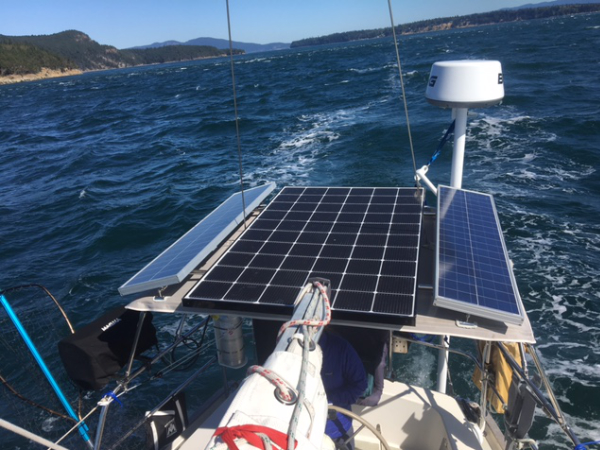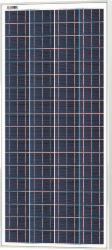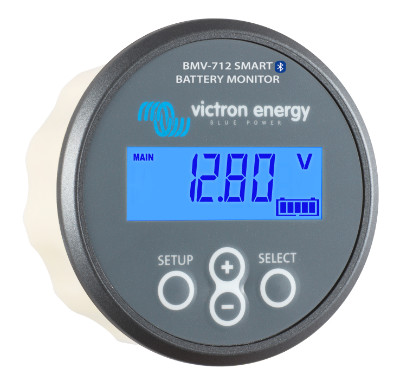Sizing Your Marine Solar System
In sizing a solar PV system the first two factors we work from are the sunlight levels or insolation values from your area and the daily power consumption of your electrical loads.

Insolation
Insolation or sunlight intensity is measured in equivalent full sun hours. One hour of maximum, or 100% sunshine, received by a module equals one equivalent sun hour. Even though the sun may be above the horizon 14 hours a day, any one site may only receive six hours of equivalent full sun. Why? For two reasons. One is reflection due to a high angle of the sun in relationship to your array. The second also due to high angle and the amount of the earth's atmosphere the light is passing through. When the sun is straight overhead the light is passing through the least amount of atmosphere. Early or late in the day, the sunlight is passing through much more of the atmosphere due its position in the sky.
Insolation Maps:
United States(73K)
Canada (58K)
Mexican, Central America & Caribbean (58K)
Northern half of South America
Southern half of South America
Mideast (42K)
Northwest third of Africa (60K)
Northeast third of Africa (56K)
Southern third of Africa (67K)
Indonesia (63K)
 The numbers listed on these maps are the average worst case insolation hours. Insolation hours provide a way of predicting the output of a solar module at a specific location. This data has typically been gathered over a number of years from weather stations located throughout the world. For example, if you have a 60W solar module that produces 3.5A peak power in a location that has 3 hours of insolation, it can be said that the 60W will produce 10.5AH a day. A word of caution. This insolation information should be used only for estimates. Solar systems should not have a final design based on this information. This map does take into account small climate changes and may not be 100% accurate for all locations. ASP has a vast resource of databases that have specific cities listed with accurate insolation data. Please allow us to verify any critical design before purchasing.
The numbers listed on these maps are the average worst case insolation hours. Insolation hours provide a way of predicting the output of a solar module at a specific location. This data has typically been gathered over a number of years from weather stations located throughout the world. For example, if you have a 60W solar module that produces 3.5A peak power in a location that has 3 hours of insolation, it can be said that the 60W will produce 10.5AH a day. A word of caution. This insolation information should be used only for estimates. Solar systems should not have a final design based on this information. This map does take into account small climate changes and may not be 100% accurate for all locations. ASP has a vast resource of databases that have specific cities listed with accurate insolation data. Please allow us to verify any critical design before purchasing.
Our sun trackers can help reduce reflectance but cannot help with the increased atmosphere in the sun's path.
Because of these factors our most productive hours of sunlight are from 9:00 a.m. to 3:00 p.m. around solar noon. Before and after these times we are making power at lower levels.
When we size solar modules, we take these equivalent full sun hour figures per day and average them over a given period. See the chart above. We like to work with two figures here: average annual equivalent full sun hours and average winter equivalent full sun hours. In most locations in the United States winter yields the least sunlight because of shorter days and increased cloud cover, as well as the sun's lower position in the sky.
Calculating Power Consumption
 After determining the amount of solar radiation available, we must next determine the size of the load that we are supplying with power. The unit of measure for sizing is either watt-hours or amp-hours. We normally use watt-hours because it applies to both AC and DC circuits.
After determining the amount of solar radiation available, we must next determine the size of the load that we are supplying with power. The unit of measure for sizing is either watt-hours or amp-hours. We normally use watt-hours because it applies to both AC and DC circuits.
The procedure is the same for all systems, regardless of whether the load is a telecommunications repeater or a house. What we need to end up with is a figure of the average daily watt-hours consumed. This will allow us to determine how many modules will be needed to produce the power and how many batteries will be needed to store the power.
The table on this page is an analysis of energy usage for a representative small home. We have itemized each appliance and its individual run time per day and per week. We then summed the watt hours of all the individual units for a total daily watt hour figure. Making up a chart such as this will allow you to understand where your power is going and may give you ideas for how to reduce your loads in the most effective manner.
 Incorrectly assessing loads can end up being frustrating and expensive. Under estimating your loads can lead to major system inadequacies. Over estimating will lead to excess capacity. While many of our hybrid systems have a range of flexibility in providing power, some systems do not. But both problems can be avoided by careful assessment of loads.
Incorrectly assessing loads can end up being frustrating and expensive. Under estimating your loads can lead to major system inadequacies. Over estimating will lead to excess capacity. While many of our hybrid systems have a range of flexibility in providing power, some systems do not. But both problems can be avoided by careful assessment of loads.
Volts x Amperes = Watts
Watts x Hours of Use = Watt-hours
We cannot over emphasize the importance of putting together the most accurate information. you can. Without it we are only guessing
Load Evaluation Form
|
Appliance
|
Watts
|
Qty
|
Hrs per day
|
Days per week
|
Total / 7
|
Avg watt-hours /day
|
|
Coffee maker
|
800
|
1
|
.2
|
7
|
1120 / 7
|
160
|
|
microwave
|
1000
|
1
|
.2
|
7
|
1400 / 7
|
200
|
|
Ceiling fan
|
10
|
1
|
24
|
7
|
1680 / 7
|
240
|
|
20" Television
|
75
|
1
|
3
|
7
|
1575/ 7
|
225
|
|
3 - 60 Watt lights
|
60
|
3
|
4
|
7
|
5040/ 7
|
720
|
|
Refrig./Freezer - 10 C.F.
|
60
|
1
|
15
|
7
|
6300 / 7
|
900
|
|
Total watt-hours per day
|
|
|
|
|
|
2445
|
Solar Array Sizing
Use this example to determine your solar module requirements. We have included an example column and a column for your system. Give us a call if we can be of help.
|
Item
|
Description
|
Example
Winter
|
Example
Yearly average
|
Winter
|
Yearly average
|
|
1
|
Locate your site on the winter and yearly isolation map and list the nearest figures.
|
2.5
|
5
|
|
|
|
2
|
Take the daily corrected total loads in watt-hours from your load calculation
|
1000
|
1000
|
|
|
|
3
|
Divide line 2 by line 1. This is the number of watts we need to generate per hour of full sun
|
400
|
200
|
|
|
|
4
|
Find actual power produced by your selected module and enter here. (Rated amperage x battery charging voltage.) 13 volts is a common charging voltage for 12 V systems.
|
91
|
91
|
|
|
|
6
|
Divide line 3 by line 4. The result is the number of modules required for your system. When rounding this number, remember that sets of 2 modules are needed for 24 volt systems, 4 for 48 volt system.
|
4.3
|
2.2
|
|
|
You can see from the example that almost twice the number of modules are required in the winter because in this instance we have half as much available sunlight. In the northerly climates this is often aggravated by a larger wintertime demand for more lights. For this reason we often size residential solar power systems (in the interest of cost effectiveness) to provide 100% of summer or yearly average loads and meet the winter shortfall with a generator. Remote communications are generally sized to winter conditions.
|
Item
|
BATTERY BANK SIZING
|
Example
|
Your Calculations
|
|
1.
|
Determine total watt-hours per day required from your load calculation sheet.
|
1000
|
|
|
2.
|
Determine days of storage required. This approximates the greatest number of cloudy days in a row expected ( 3 to 7 is common for residences, 7 to 14 for remote communications and monitoring sites )
|
7
|
|
|
3.
|
Multiply line 1 by line 2.
|
(1000 x 7)
7000
|
|
|
4.
|
Determine planned depth of discharge, 80% is the maximum for lead acid deep cycle batteries, 50% a common amount for optimum longevity. Divide line 3 by .80 or .50, respectively.
|
(.50)
14,000
|
|
|
5.
|
De-rate your battery for low temperatures by multiplying line 4 by the factors in the table below using lowest expected weekly average temperature.
|
Battery
Temp
|
Multiplier
|
|
|
Battery
Temp
|
Multiplier
|
|
80
|
1.0
|
|
|
40
|
1.3
|
|
70
|
1.04
|
|
|
30
|
1.4
|
|
60
|
1.11
|
|
|
20
|
1.59
|
|
50
|
1.19
|
|
|
|
|
|
(14000 x 1.04)
14,560
|
|
|
6.
|
Find the watt-hour capacity of your selected battery This is voltage times ampere-hour capacity. Example: L-16 deep cycle, 6 volts x 350 amp-hours.
|
(6 x 350)
2100
|
|
|
7.
|
Divide line 5 by line 6. The result is the number of batteries required.
|
6.9
|
|
|
8.
|
Round number of batteries to fit system voltage. Example: A 12 volt system requires a set of 2 when using 6 volt batteries. a 24 volt system requires a set of 4 6 volt batteries.
|
8
|
|
Note: The battery amperage should normally be at least 5 times the hourly amperage draw of the largest appliance or 5 times the highest hourly amperage output of the battery charger.